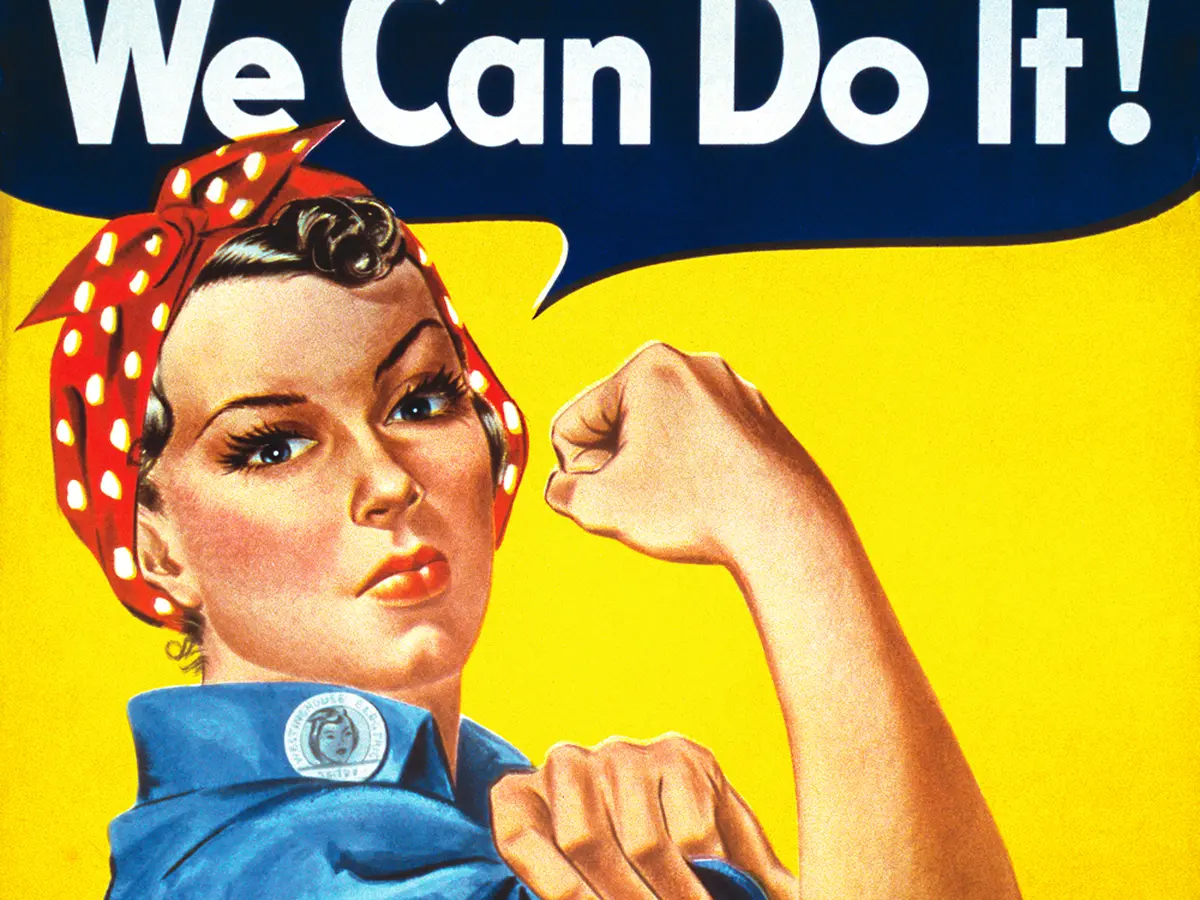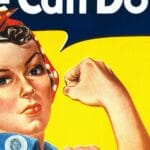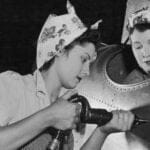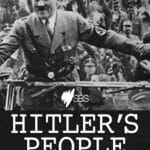Rex the Riveter Propaganda Posters: Flexing Strength in Wartime
You’ve likely heard of Rosie the Riveter, the iconic image of a woman flexing her bicep, encouraging women to join the workforce during World War II. But did you know Rosie had a lesser-known counterpart, a brawny fella named Rex the Riveter? While Rosie rallied women on the home front, Rex’s mission was to fire up the men – the backbone of America’s wartime industry.
Imagine this: It’s the 1940s, and the nation is deeply embroiled in a global conflict. Factories are buzzing, relentlessly churning out tanks, planes, and ammunition around the clock. The demand for manpower is insatiable, and that’s where Rex makes his entrance. His chiseled jawline and powerful physique, often dramatically depicted wielding heavy machinery, were plastered on posters across the country. Rex was more than just a pretty face; he was a carefully crafted symbol of American grit, determination, and the ideal man.
These posters weren’t merely about aesthetics; they were strategically deployed tools of wartime propaganda. Rex’s image was meticulously crafted to inspire, motivate, and even shame men into working harder and faster. The message was clear and urgent: our boys overseas are counting on you! It was a resounding call to action, urging every man to step up and do his patriotic duty, effectively equating industrial productivity with unwavering patriotism.
Some historians suggest that Rex’s portrayal may have strategically played on traditional notions of masculinity, tapping into the deeply ingrained idea that a “real man” contributes to the war effort through physical labor. This, however, remains a subject of debate among scholars, with some arguing that Rex’s image transcended gender stereotypes, embodying the shared spirit of sacrifice and resilience desperately needed in those challenging times.
While Rex might not be as instantly recognizable as his female counterpart, Rosie, today, his impact on wartime morale shouldn’t be underestimated. His image serves as a fascinating reminder of how visual imagery can be skillfully harnessed to rally a nation, bolstering the home front’s spirit while the world was at war. Although further research is needed to fully grasp the complexities of Rex’s reception and influence, his legacy endures as a powerful symbol of the vital role played by industrial workers, both male and female, during World War II.
Have you ever wondered how the iconic image of Rosie the Riveter came to be? Delve into the fascinating origin of Rex the Riveter and discover the remarkable story behind the symbol of women’s empowerment during World War II. Additionally, explore the pivotal role played by women in World War II as they stepped up to support the war effort in unprecedented ways.
What is the most famous propaganda poster?
Picking the absolute most famous propaganda poster is a daunting task, but when considering sheer recognizability and lasting cultural impact, “Rosie the Riveter” emerges as a strong contender. You know the one: a determined-looking woman confidently flexing her bicep, with the bold words “We Can Do It!” splashed across the image.
This iconic image, first created in 1943 by J. Howard Miller for Westinghouse Electric, wasn’t originally intended to be a massive cultural phenomenon. It was designed to boost morale and keep workers productive during World War II, displayed primarily inside factories. It wasn’t until later, thanks in part to Norman Rockwell’s own interpretation of Rosie on the cover of the Saturday Evening Post, that the image truly took off as a symbol of female empowerment.
Interestingly, while many associate Rosie with recruiting women into the workforce, the poster itself wasn’t actually about recruitment. Instead, it focused on motivating those already working in factories to give their all for the war effort.
Over time, the meaning of Rosie has continued to evolve. She’s become a feminist icon, a symbol of resilience, and even a political image adopted by various movements. It just goes to show how a single image, created with a specific purpose in mind, can take on a life of its own and resonate with people in ways its creator never imagined.
What did the propaganda poster Rosie the Riveter symbolize?
Rosie the Riveter represents a pivotal turning point for women during World War II. With millions of men away fighting, someone had to keep the factories running and the home fires burning, and women stepped up in a big way.
The most famous Rosie image, the super-strong lady flexing her muscles, was designed by J. Howard Miller in 1942. However, it was superstar artist Norman Rockwell who catapulted her to household name status with his 1943 painting on the cover of the Saturday Evening Post.
Rockwell’s Rosie was no delicate flower. He painted her as a tough, hardworking woman who wasn’t afraid to get her hands dirty, shattering those old-fashioned ideas about what women could and couldn’t do. This wasn’t just about women doing “men’s work”; it was about women proving their strength and showing everyone that they were vital to the war effort. Rosie’s image was like a rallying cry, popping up everywhere to inspire people on the factory floor and back on the home front.
Rosie’s impact went way beyond the war years. Even today, she’s a powerful symbol of women’s independence and the important roles they play in our world. She reminds us that women are capable of amazing things when they put their minds to it.
Consider these points:
- Before Rosie, most people believed a woman’s place was in the home. Rosie helped change that whole mindset.
- Her image wasn’t just about getting women into factories; it was about showcasing their strength, determination, and patriotism.
- Even today, Rosie reminds us that progress isn’t always easy, but it’s always worth fighting for.
What was so controversial about Rosie the Riveter?
Rosie the Riveter, that super-strong woman with the flexed bicep and the “We Can Do It!” attitude, has become the ultimate symbol of women stepping up during World War II. However, the “Rosie the Riveter” phenomenon wasn’t as simple or inclusive as it seemed.
The image we all recognize—created by J. Howard Miller—was part of a large-scale government campaign to encourage women to fill factory jobs left vacant by men fighting overseas. While the campaign successfully mobilized women, the image itself missed the mark in representing the diverse range of women who answered the call.
The picture of Rosie—a white woman with a bandana and perfect hair—didn’t reflect the reality of the women working tirelessly in those factories. Women of color, immigrant women, and women from various backgrounds contributed significantly to the war effort, yet they didn’t see themselves represented in Rosie’s iconic image. This inadvertently silenced the voices and contributions of many while highlighting a select few.
Furthermore, some argue that the entire “Rosie” narrative, despite its good intentions, still confined women to traditional roles. While it celebrated their strength and capability, it primarily focused on their contributions to factories, neglecting their potential in other fields like medicine, science, and leadership.
Today, the conversation surrounding Rosie continues, advocating for recognition and celebration of all women who contributed to the war effort. This push for a more inclusive historical narrative emphasizes the importance of honoring the true diversity of women who rolled up their sleeves and proved their immense capabilities.
The complexities surrounding Rosie demonstrate how even well-intentioned initiatives can have unintended consequences. It underscores the importance of continuous dialogue and critical examination of historical narratives, even decades later. This ensures a more accurate, inclusive, and richer understanding of the past, giving voice to those who may have been unintentionally marginalized.
What is the message of the We Can Do It! propaganda poster?
While initially intended to bolster morale in factories during World War II, the “We Can Do It!” poster’s message resonates far beyond its initial context. Featuring a woman, often associated with Rosie the Riveter, flexing her muscles and donning a determined expression, the poster exudes an aura of capability and determination.
The poster suggests that anyone, regardless of gender, can rise to the occasion and make a difference when faced with adversity. It’s about tapping into one’s inner strength and demonstrating true capabilities.
The poster’s message has transcended its wartime origins, appearing in feminist movements, political campaigns, and various social causes. It serves as a potent reminder that obstacles can be overcome and that human willpower, especially when collectively harnessed, is a force to be reckoned with.
Some might see a simple poster, but others recognize a rallying cry for resilience, a testament to the inherent strength within us. It reminds us that we are all capable of achieving remarkable things with unwavering determination and a belief in our abilities. The “We Can Do It!” poster emphasizes our shared capacity for greatness and encourages collective effort in the face of challenges.
What is the most famous poster of all time?
Choosing the absolute most famous poster is subjective; however, “We Can Do It!” featuring Rosie the Riveter, with its instantly recognizable imagery, cultural impact, and timeless message, is undoubtedly a top contender.
Created by J. Howard Miller in 1943 for Westinghouse Electric, the poster wasn’t originally intended to be a feminist icon. Its initial purpose was to encourage women to fill factory jobs vacated by men fighting in World War II. However, the image of Rosie, with her work clothes, flexed biceps, and determined expression, clearly resonated on a deeper level.
Although not widely circulated during the war, the poster’s rediscovery in the 1980s propelled it to legendary status. It became a symbol of female empowerment, a powerful testament to women’s contributions during challenging times, and a reminder that we all possess the inner strength to tackle formidable tasks.
The evidence of its impact is undeniable. Rosie’s image has been parodied, recreated, and referenced countless times, appearing on everything from t-shirts to coffee mugs. Moreover, her image continues to surface in protests and movements championing equality. Even without knowing its backstory, the message behind “We Can Do It!” is instantly clear—a testament to the power and enduring legacy of this image.
What is the number one poster of all time?
Declaring a single “best” poster of all time is an impossible task, as personal preferences vary widely. However, when discussing iconic posters from World War II, two contenders consistently top the list: the inspiring Rosie the Riveter and the commanding Uncle Sam.
Rosie the Riveter: More Than Just a Pretty Face
During World War II, women played a critical role in maintaining the home front and filling industrial positions vacated by men fighting overseas. Rosie the Riveter became the symbolic representation of these hardworking women. Her iconic “We Can Do It!” poster, with Rosie in her work clothes flexing her bicep, transcended its initial purpose of recruitment. It evolved into a powerful symbol of their strength, determination, and vast contributions to the war effort.
Uncle Sam: He Wants YOU! (Maybe)
The “I Want You” poster featuring Uncle Sam exudes an air of authoritative urgency. A recruiting tool since World War I, Uncle Sam’s stern gaze, pointing directly at the viewer, became an iconic image during World War II. Representing the United States, his image urged Americans to fulfill their patriotic duty and enlist.
Why These Posters Still Matter Today
These posters’ enduring relevance stems from their ability to encapsulate the emotions and challenges of a generation. Today, Rosie represents female empowerment, while Uncle Sam embodies American patriotism, demonstrating the profound and lasting impact of images in shaping history and culture.
Exploring Further
While Rosie and Uncle Sam are iconic, countless other impactful posters from that era deserve exploration. Each poster tells a unique story and reflects the historical context. By studying them, we gain a deeper understanding of the past and its resonance in the present.
What was the most popular form of propaganda?
During times like World War II, propaganda was a ubiquitous presence. Imagine walking down a street back then—posters would be plastered everywhere—on walls, shop windows, and even fences. Posters were the social media of the 1940s—easy to produce in mass quantities, inexpensive, and impossible to ignore. Their widespread use was crucial in an era when not everyone had access to radios or televisions.
The effectiveness of posters, however, extended beyond mere convenience. They possessed a unique ability to ignite emotions and shape perspectives. A single striking image or a catchy slogan could evoke stronger reactions than a lengthy speech, making them powerful tools for governments. They were used to:
- Boost Morale and Patriotism: Posters depicting brave soldiers with determined expressions, accompanied by slogans urging support for the troops, fostered a sense of unity and national pride.
- Encourage Military Enlistment: Some posters highlighted the camaraderie and sense of purpose found in military service, while others employed fear tactics, portraying the enemy as menacing figures.
- Promote War Efforts: The iconic “Rosie the Riveter” poster encouraged women to take on traditionally male-dominated jobs, highlighting their crucial role in supporting the war effort.
- Demonize the Enemy: Posters often resorted to using exaggerated or frightening depictions of the opposing side, fueling hatred and justifying the war.
The iconic status of “Rosie the Riveter,” even after the war, underscores the lasting impact a simple poster can have. Her image evolved into a symbol of female strength and their crucial contribution to the war effort, demonstrating the power of visual imagery in shaping societal values.
While pinpointing the most popular poster is difficult, it’s safe to say that posters, due to their accessibility, visual appeal, and emotional impact, reigned supreme as the most prevalent form of propaganda during World War II.
What are three famous propaganda taglines?
Propaganda posters relied heavily on memorable taglines to embed their messages deeply within the public consciousness. These carefully crafted phrases were strategically designed to evoke specific emotions and rally support for the war effort.
One such enduring tagline is “We Can Do It!” from the iconic poster featuring a determined woman, often linked to Rosie the Riveter, flexing her bicep. This image became synonymous with female empowerment during World War II, capturing the spirit of women stepping up to fill traditionally male-dominated roles.
From Britain came the reassuring message, “Keep Calm and Carry On.” This simple yet powerful phrase encouraged resilience and perseverance in the face of adversity. Imagine facing bombing raids and wartime uncertainties—this poster provided a much-needed sense of hope and stability.
Playing on a different set of emotions, “Loose Lips Sink Ships” instilled a sense of caution and secrecy. This tagline implied that even casual conversations could jeopardize the war effort, encouraging people to be mindful of their words and avoid sharing sensitive information.
These taglines transcended their visual counterparts, seeping into the public lexicon and shaping behavior. While some argue that they oversimplified complex issues or instilled unnecessary fear, their effectiveness in rallying support, boosting morale, and emphasizing individual responsibility during wartime is undeniable.
The enduring presence of these taglines, often appearing on merchandise and in popular culture, speaks to their lasting impact. They serve as reminders of the power of language and the clever ways in which simple phrases can unite a nation during extraordinary times.
It’s important to note that the study of propaganda is ongoing, and experts may have different interpretations of these posters and their effectiveness.
What is the most famous propaganda poster for WWI?
Imagine scrolling through your social media feed in the 1910s and encountering the Uncle Sam, the one with the piercing gaze and pointed finger, as if singling you out from the crowd. That, my friends, is likely the most famous propaganda poster to emerge from World War I—James Montgomery Flagg’s “I Want You for the U.S. Army.”
Flagg’s creation wasn’t just a poster; it was a powerful call to action, designed to resonate deeply with everyday Americans. It employed a simple yet effective formula: Uncle Sam, a symbol of America itself, making direct eye contact with the viewer, accompanied by a pointed finger that felt intensely personal, and a clear, concise message— “I Want You for the U.S. Army.”
Experts attribute its effectiveness to its simplicity. Uncle Sam, representing the nation, personally calls upon individuals to serve their country. The pointing finger creates a sense of individual responsibility, while the catchy slogan leaves a lasting impression.
The “I Want You” poster, however, wasn’t alone. Posters urging factory workers to increase production, families to conserve resources, and citizens to contribute financially saturated the public sphere. Each poster was strategically crafted to resonate with a specific audience and evoke a particular emotion.
These posters, plastered on buildings, inside homes, and displayed in shop windows, were inescapable reminders of the ongoing war and the expected roles of citizens. They provide a glimpse into the past, highlighting the power of visual persuasion and how art can be used to shape public opinion, for better or worse.
Want to Dive Deeper?
The Library of Congress has a treasure trove of WWI propaganda posters. You can explore them here: https://www.loc.gov/pictures/collection/wwipos/
What is the name of the famous propaganda poster girl?
The woman confidently flexing her bicep in the “We Can Do It!” poster is none other than Rosie the Riveter, who rose to cultural icon status during World War II. With millions of men away fighting, women took on crucial roles in factories, producing war supplies. J. Howard Miller’s poster, while not initially intended to depict Rosie, captured the spirit of these women. Rosie, with her work clothes and determined expression, wasn’t about conforming to traditional beauty standards; she represented strength, capability, and the essential contributions of women to the war effort.
Propaganda posters were the social media of their time, designed to rally the public, boost morale, and garner support for the war effort. Rosie’s image resonated deeply, showcasing a woman who wasn’t afraid to roll up her sleeves and get things done.
Even today, Rosie’s image remains a powerful symbol of female empowerment, reminding us that women are capable of achieving great things when they set their minds to it.
- Unlocking Francis Alexander Shields’ Finance Empire: A Comprehensive Biography - July 12, 2025
- Unveiling Francis Alexander Shields: A Business Legacy - July 12, 2025
- Francis Alexander Shields’ Business Career: A Comprehensive Overview - July 12, 2025















